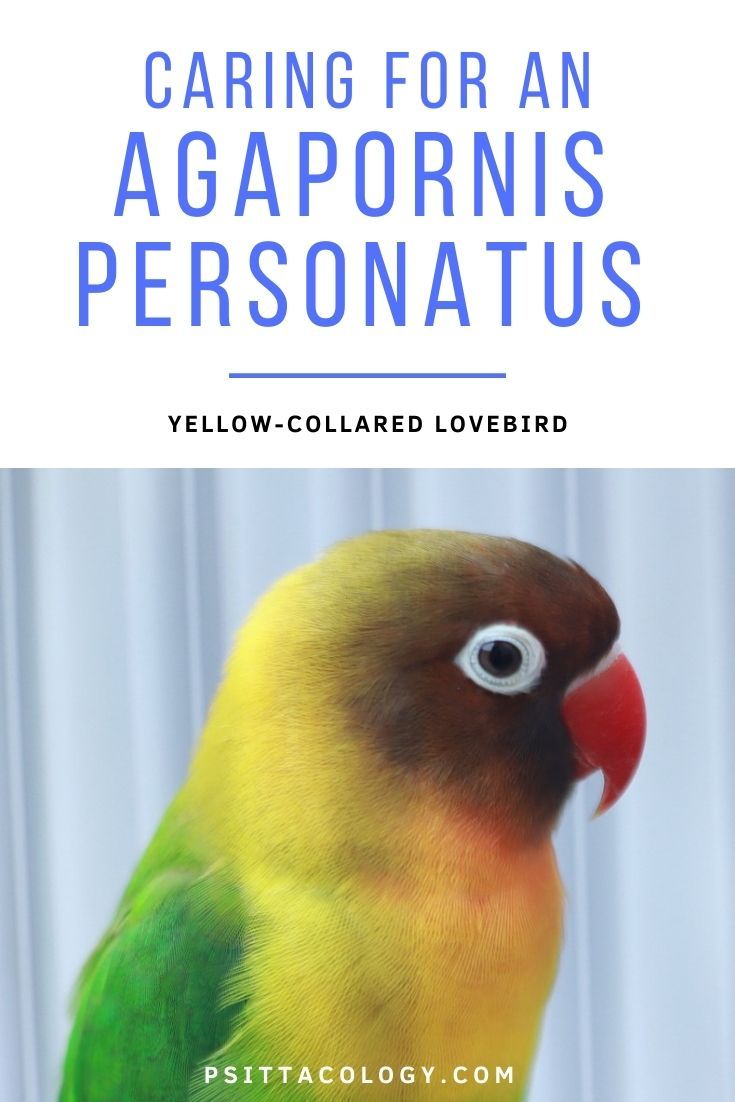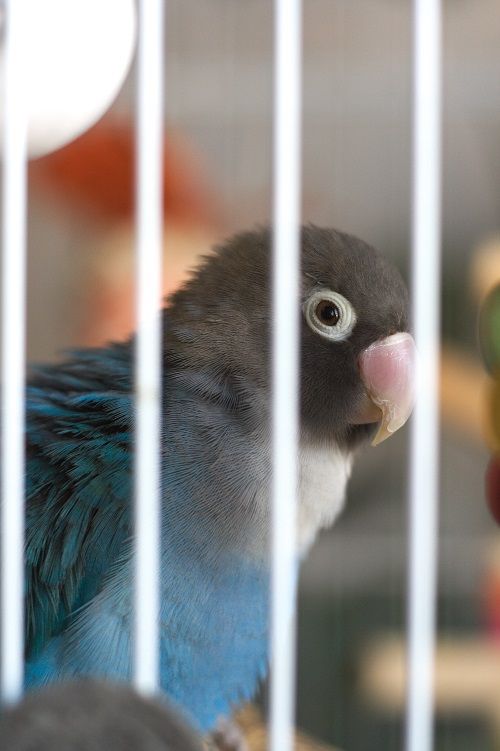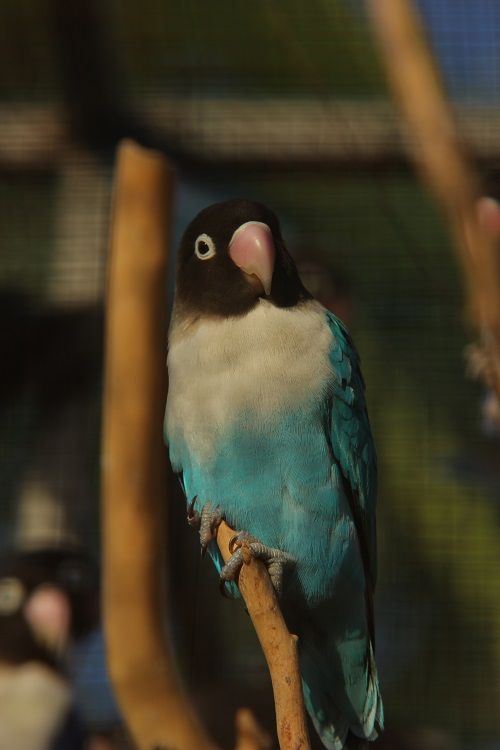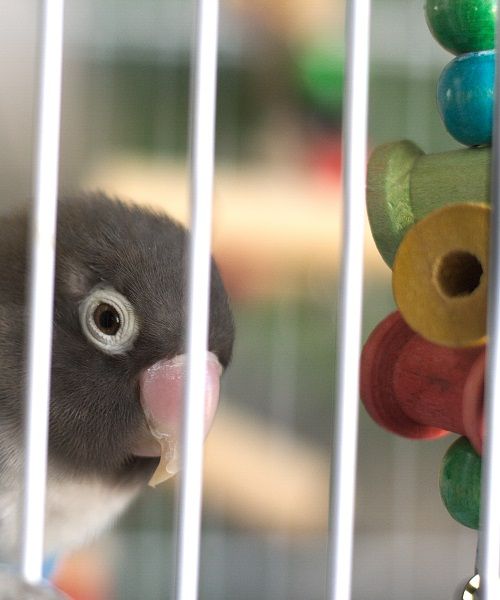Looking to add a lovebird to your family? It’s easy to fall in love with the yellow-collared lovebird (Agapornis personatus). Their beautiful colors and small size make them very handsome little parrots, but it’s important to research their care before you head out to buy one!
Keep reading for everything you need to know about yellow-collared lovebird care and how to keep yours as happy and healthy as can be.
| Name(s) (common, scientific) | Yellow-collared lovebird, masked lovebird, eye-ring lovebird*, Agapornis personatus, sometimes Agapornis personata |
| Natural habitat | Tanzanian grassland |
| Adult size | 5.5″ (14 cm), ~50 grams |
| Lifespan | Up to 20 years |
| Noise level | Not too noisy, but very shrill |
This post contains affiliate links. If you make a purchase, a small percentage will go directly to Psittacology at no additional cost to you. Thank you for supporting Psittacology!
Yellow-collared lovebird appearance
Agapornis personatus is part of the eye-ring subgroup of lovebirds, which can be recognized from the bare white ring around their eyes. They’re quite similar in appearance to some other members of this group, especially Agapornis fischeri or the Fischer’s lovebird, which is also a popular pet.
So how do you tell a yellow-collared lovebird apart from a Fischer’s? The wild type features a very dark brown (almost black) head, yellow breast and neck, dark green wings and a light green belly, back and tail. Their beak is red. Unfortunately, telling the difference between males and females visually isn’t really possible.
The key to making sure you’re dealing with a personatus and not a fischeri is the head: it’s much darker on the former. This applies to almost all color varieties, of which there are quite a few! Both species have been selectively bred pretty extensively.
Yellow-collared lovebirds (Agapornis personatus) can be found in wild type color, blue (with a grey neck and beige beak), blue-green, violet (wings leaning towards purple), lutino (white) and quite a bit more, including varieties with red heads and/or mottled wings.

Yellow-collared lovebird origin & natural habitat
Like other lovebird species, Agapornis personatus is naturally found on the continent of Africa. Specifically, it hails from Tanzania, although it’s also an invasive species in other countries, including outside of Africa.
In Tanzania, yellow-collared lovebirds inhabit grasslands and savannah habitats, moving in flocks that can range from a few birds to many dozens. Their preferred areas are always dotted with trees like Acacia, as these form an important part of the wild lovebird lifecycle. Tree hollows are used to build nests.
Yellow-collared lovebirds are not considered threatened in their natural habitat. Although they’re probably trapped for food and the pet trade, they’re listed as Least Concern on the IUCN Red List.
Yellow-collared lovebird diet
Wild diet
In the wild, Agapornis personatus is mainly a seed eater. With its comparatively large beak, cracking open its lunch is a breeze! Grass seeds like millet as well as sorghum and Acacia are favorites.
Like many parrots, wild and feral yellow-collared lovebirds will raid farmers’ crops, leading to a local status as a crop pest. They’ll happily go for millet, corn and more.
Domestic diet
To keep your pet lovebird happy and healthy, it’s important to feed a varied diet. This isn’t easy, as we don’t have access to all the seeds they would eat in the wild in all their stages of ripeness. Obesity can also be an issue, as our domestic lovebirds just don’t move around as much as their wild counterparts do.
So what should you be feeding your yellow-collared lovebird? Some seeds are fine, but for the bulk, it’s a good idea to go for an option that’s lower in calories and higher in (micro)nutrients. You could try a mix of the following:
- Small, high-quality parrot pellets as a staple
- A high-quality small parrot seed mix (sprouted seeds are an especially great option)
- Fresh vegetables (see the list of vegetables for parrots).
- Occasional fresh fruits (see the list of fruits for parrots)
- Foraged foods like parrot-safe weeds, grasses and branches.
Your Agapornis personatus should always have access to fresh water, preferably from multiple sources, and a calcium block.
If you’re stumped on what to feed and how much, have a look at the full guide to parrot diet.

Yellow-collared lovebird temperament
Let’s get to the bit that lovebirds in general are known for! Don’t let their size fool you: Agapornis personatus is an absolute pocket rocket. These guys are inquisitive, active, loud, social and often feisty. They can be on the bitey side, so inform yourself about parrot taming to make sure you can promote desirable behaviors in your bird.
It’s often thought that lovebirds absolutely have to be kept in pairs, hence their common name. In Spanish, they’re even known as inseparables, with a common belief that they’ll die if their mate is taken away. I’m not sure where this stems from, as lovebirds don’t seem to bond more strongly with their mate than, say, a budgie parakeet.
You don’t have to keep lovebirds in pairs, although they do appreciate having a mate. You definitely shouldn’t keep one alone if you work outside of the home for 8 hours a day, for example!
A pair might become somewhat more focused on each other than on you, but with proper training, you should still be able to maintain your bond. If you do have plenty of time to spend with your yellow-collared lovebird, you can keep it alone.

Yellow-collared lovebird housing
Although they’re small, yellow-collared lovebirds still need plenty of room to move around. The minimum size I’ve often seen mentioned is 18″ x 18″ (45 x 45 cm). This works, but it does mean that you’ll have to keep the door open for most of the day.
If your Agapornis personatus will be spending most of its time inside of its cage, you’ll have to go a lot bigger (double, for example).
The bar spacing on your yellow-collared lovebird’s cage shouldn’t exceed 1/2″ (1.3 cm) to avoid its head getting stuck. Additionally, the cage should contain at least the following:
- One or multiple food stations + cuttlebone or calcium block
- One or multiple water stations
- Natural perches (no plastic or dowel), most placed near the top
- Parrot toys (shredding toys, foraging toys, foraged parrot-safe branches and/or homemade toys if you’re on a budget)
Yellow-collared lovebird enrichment
Like other parrots, yellow-collared lovebirds are smart. They naturally spend most of their day foraging and figuring out how to find food. In your home, you’ll have to find a way to give that clever brain plenty of problems to solve to prevent (self-)destructive behaviors!
So how do you ensure your Agapornis personatus lives a happy and fulfilled life? There’s plenty you can do.
- Social interaction. You probably guessed it from the previous section on temperament: Yellow-collared lovebirds need lots of attention. It can be from you or from a mate, but they can’t be left alone for extended periods of time. Talk to your bird, play, offer head scratches or just hang out together.
Tip: Training is the perfect double-whammy. It offers both social interaction and bonding time, as well as the opportunity to teach your yellow-collared lovebird positive behaviors or even fun tricks.
- Out-of-cage time. Unless your lovebird is in a large flight cage (and really, even then), the opportunity to explore a parrot-safe room will be much appreciated and help prevent obesity-related health issues.
You can place a playground on top of the cage for your bird to use as a “home base” during its free-roaming time.
- Toys. Colorful, jingly, rustling, preenable, shred-a-licious: parrots love toys. Rotate a nice selection to keep things exciting. Don’t forget that for a parrot, anything can be a toy. It doesn’t have to be expensive as long as it’s safe. Muffin papers stacked on a string are already a spectacle in a lovebird’s eyes!
- Bath. Don’t forget to provide your yellow-collared lovebird with a bathing dish. This species is known for having a particular affinity for water. Many also love to be sprayed.
- Foraging. In the wild, your Agapornis personatus wouldn’t have a food bowl. It has to find food itself and it’s good at it. So why not make it work a bit for its meal?
Use foraging toys, make a foraging box and pick pesticide-free, parrot-safe plants outside for your bird to go wild on.

Yellow-collared lovebird sounds
In terms of decibel levels, lovebirds like this one are truly impressive. Their high-pitched peeps can be truly deafening! Luckily, though, they don’t use these all day long. The loudest screams are reserved for when your yellow-collared lovebird loses sight of you or its mate.
This being said, don’t expect lovebirds to be quiet pets. While they might not do so loudly, they do spend most of the day chattering and whistling. Their noise levels increase if background noise does (they love to join in) and around dawn and dusk.
They should be reasonably well-suited to most apartment situations, but if your neighbors are sensitive, you might have to ask first.
Do yellow-collared lovebirds talk?
Like other lovebird species, yellow-collared lovebirds aren’t considered the most talented talkers by any means. However, like much of the parrot family as a whole, they do have some ability to learn to imitate sounds and short phrases.
If you’d like to know more about lovebirds and their ability to imitate human speech, head over to the article on lovebird talking.
Yellow-collared lovebird safety & emergencies
An inquisitive bird like a yellow-collared lovebird is basically a flying safety hazard, which means you’ll have to keep a close eye on your feathered pet. Every room it has access to should be parrot-safe.
It goes without saying that you should have the number for an avian vet handy, just in case an emergency arises. It also helps to know what to do in an emergency situation.
Frequently asked questions
Yes. As they belong to the same genus and are closely related, the two can interbreed. In fact, this is a common practice, although there is some discussion about whether it’s desirable or not.
It depends on the color mutation and whether a lovebird is hand-raised. Wild-color birds may cost as little as $50, while “fancy” colors can run into the hundreds of dollars.
If you have any more questions about yellow-collared lovebird care or if you’d like to share your own experiences with these colorful African parrots, don’t hesitate to leave a comment below!
Sources
Parr, M., & Juniper, T. (2010). Parrots: a guide to parrots of the world. Bloomsbury Publishing.

1 thought on “Yellow-Collared Lovebird Care & Info | Small Parrot, Big Attitude”